BetaFPV SuperG Nano Transmitter

BetaFPV SuperG Nano Transmitter
Based on ELRS V3.3 and in collaboration with the ELRS development team, the first-ever Gemini Dual-Frequency Diversity Transmitter has been released! Now the SuperG Nano transmitter can be fully activated to achieve the best link quality when combined with a receiver, such as the SuperD receiver or SuperP receiver. With dual 1W transmission power, the device excels in anti-interference performance and stability, making it ideal for demanding applications such as FPV racing, long-range flying and professional photography.
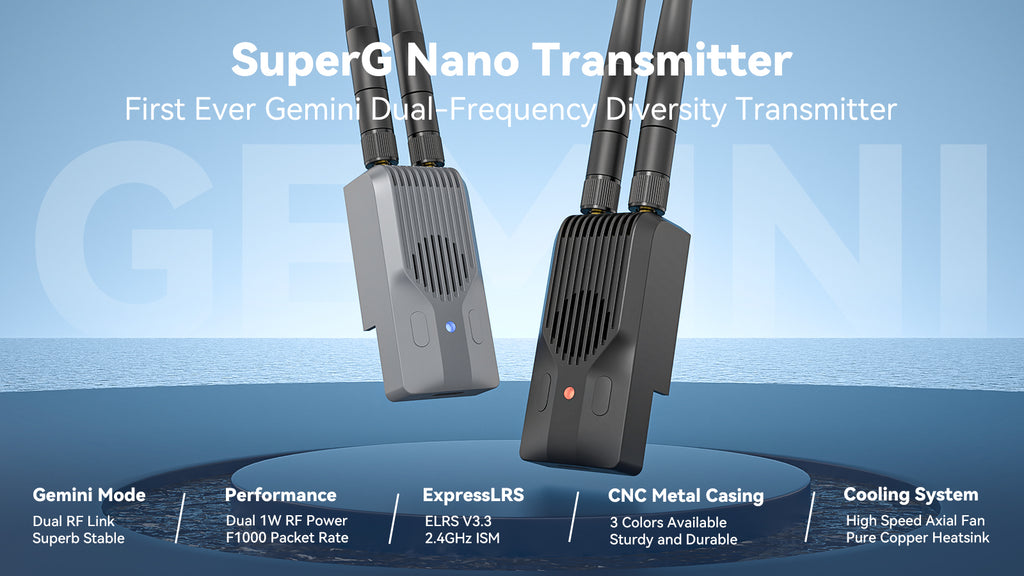
Features
- Introducing the pioneering Gemini Dual-Frequency Diversity transmitter, which brings ELRS into the era of dual-frequency capability.
- Dual transmission power of 1 watt allowed to strengthen the signal, increase the transmission distance and significantly increase the range of remote control.
- In combination with existing true diversity (diversity) receivers, activation of Gemini mode guarantees signal stability even in the most complex radio environments.
- The transmitter's housing is carefully crafted from CNC aluminum alloy, enables efficient heat conduction, and an intelligently designed heat sink system ensures optimal heat dissipation.
- The transmitter is equipped with 2 programmable buttons and 1 USB port. It can be powered from external sources for reliable long-distance expeditions.
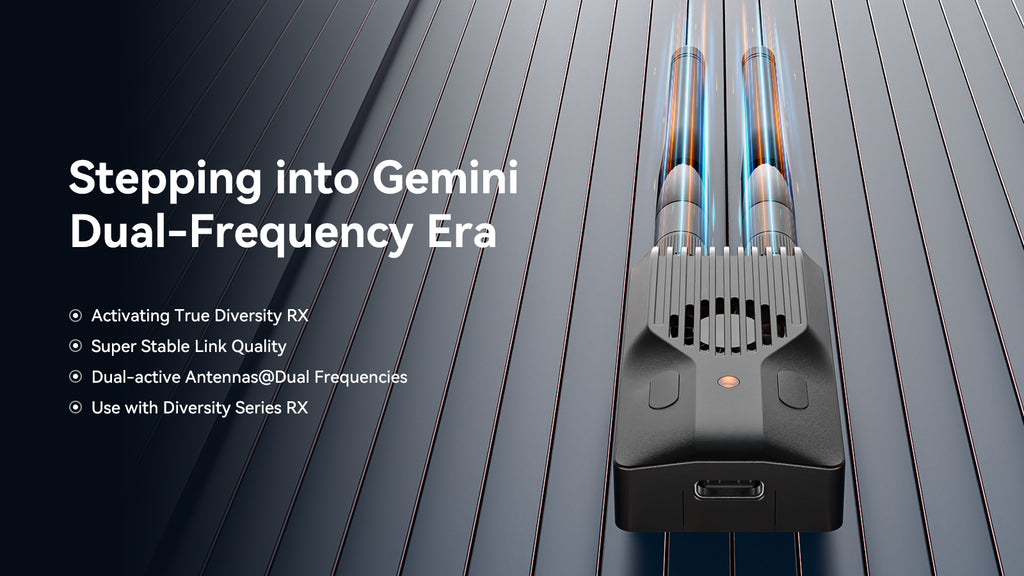
Specification
- Item: BETAFPV SuperG Nano transmitter module | ELRS 2.4G
- Weight: 44.8 g
- Color: Black
- Antenna connector: 2* RP-SMA
- RF power: 25mW/50mW/100mW/250mW/500mW/1000mW
- Packet rate: 50Hz/100Hz/150Hz/250Hz/333Hz/500Hz/D250/D500/F500/F1000
- Frequency band: 2.4 GHz ISM
- Input voltage: 7V~13V DC
- Rated current: 8 V, 1000 mA at 1000 mW, 1:128, Gemini mode
- USB port: Type-C
- Fan voltage: 5V
- Default firmware version: ExpressLRS V3.3.0
- Target name: BETAFPV SuperG Nano 2.4GHz TX
Diagram
Below is a diagram of the SuperG Nano transmitter.
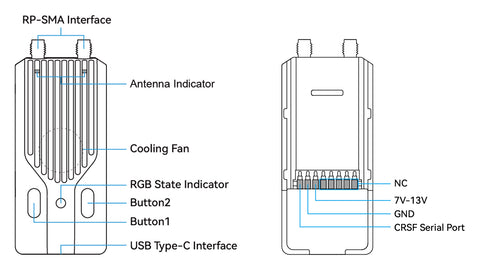
Note: Please assemble the antenna before turning on the power. Otherwise, the PA chip in the SuperG Nano transmitter will be permanently damaged.
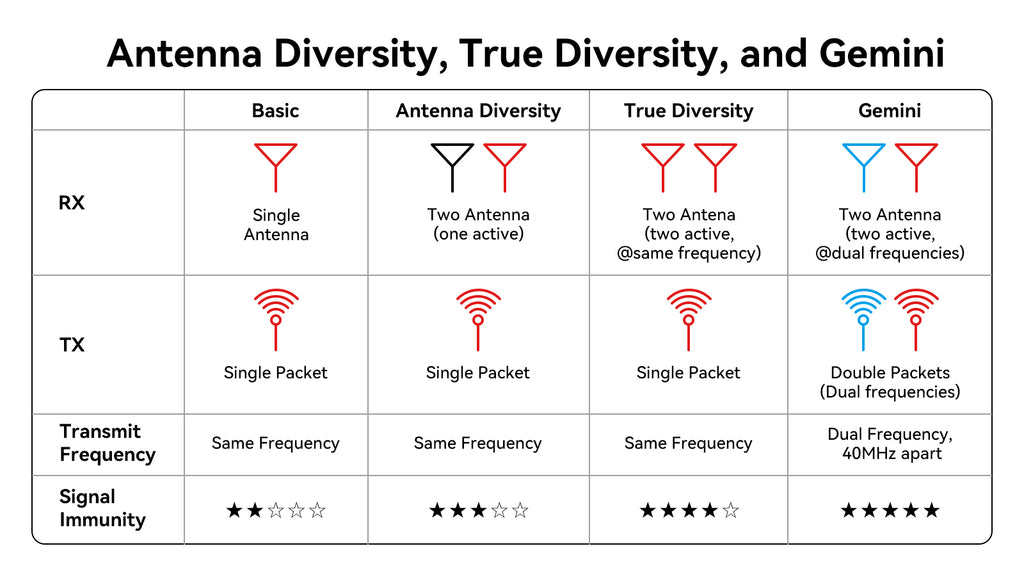
- Antenna Diversity mode, two antennas. Regularly switch the two antennas to read the RSSI value of the signal and determine which antenna to use for data reception.
- True Diversity mode, in which both antennas receive data on the same frequency, and the antenna that receives the correct data first is used.
- Gemini mode, in which two antennas simultaneously receive telemetry data with a frequency difference of 40 MHz. They also transmit data simultaneously, but at different frequencies. This means that you can receive the same data packets on different frequencies and antennas. This mode ensures stable flight even in complex radio environments.
Among them, Gemini is the most advanced ExpressLRS feature - Gemini mode currently has the most stable signal reception mode and offers higher noise immunity and stability, making it suitable for various applications.
Connection to Diversity RX
Gemini mode is built on the hardware base of true diversity receivers and requires a dual high-frequency RF module. When used with Super Series products, the advantages of Gemini mode can be fully exploited.
Basic configuration
The SuperG Nano transmitter is designed to receive signals using the Crossfire Serial Data Protocol (CRSF). Therefore, the high-frequency module interface of the transmitter must support the CRSF signal output. Taking the EdgeTX transmitter system as an example, we will explain how to configure the transmitter to send CRSF signals and control the transmitter using Lua scripts.
On the EdgeTX system, go to MODEL SEL and enter the SETUP menu. Turn off Internal RF (set to OFF), turn on External RF and set Output Mode to CRSF, as shown in the following figure.
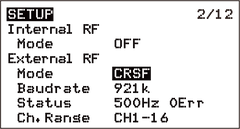
LUA scripts is a lightweight and compact scripting language that can be embedded in the transmitter for convenient access and modification of the transmitter configuration.
- Download elrsV3 script.lua from the BETAFPV help center or the ExpressLRS configurator.
- Copy the official Lua script, elrsV3.lua, to the transmitter's SD card, to the Scripts/Tools track.
- On the EdgeTX system, press and hold the SYS or MENU button to access the SD-HC card menu.
- In this menu, select elrsV3 script.Lua and run it.
- If the Lua script is run correctly, the interface will look as shown in the following illustration.

Custom buttons
The SuperG Nano transmitter has 2 buttons that can be customized by users. Here are the specific handling steps:
- Turn on WiFi of the transmitter or turn it on and wait 60 seconds to enter WiFi mode using LUA programming.
- The RGB light will slowly flash green, indicating that the transmitter has automatically enabled WiFi (WiFi name: ExpressLRS TX, WiFi password: expresslrs).
- Connect your smartphone or computer to a WiFi network and open a web browser. Enter http://10.0.0.1 to access the custom button settings page.
- In the appropriate column of the Button Action, select the desired custom function. Then select the type of button and the number of presses or duration in the Press and Count columns. Click SAVE to complete the settings.
External connection and power supply
The SuperG Nano transmitter uses the default firmware, which uses the official ExpressLRS V3.3.0 protocol without Binding Phrase. Therefore, the binding receiver should also be equipped with firmware V3.0.0 or later and not have Binding Phrase set up. For optimal performance, it is recommended to position the two transmitter antennas as far apart as possible.
- Put the receiver in the binding state and wait for a call.
- Click "Bind" in the Lua script or the Custom Set button to enter the binding mode.
- If the indicator lights up continuously, it means that the device has been successfully paired.
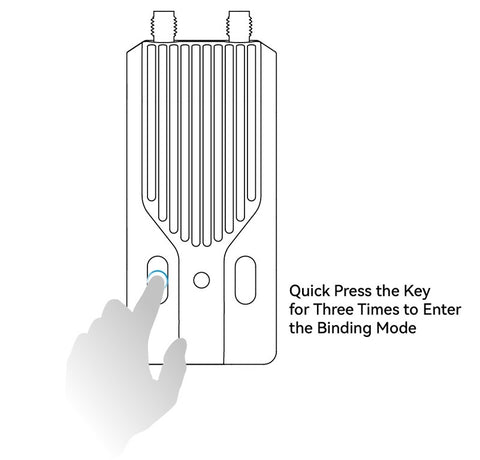
Note: If the TX firmware is flashing again and Binding Phrase is configured, you cannot enter the Binding state using the above method. Set RX to the same frequency Binding Phrase, and TX and RX can be connected automatically.
When the dual-transmission power exceeds 500 mW, the SuperG Nano transmitter exhibits relatively high power consumption, leading to reduced battery life. To extend the life of the transmitter, it is recommended to use an external battery as a power source.
- Transmitter power consumption is not only related to transmit power, but also to the telemetry factor. When using high power of 500 mW and above, the return factor can be set higher to reduce power consumption and extend the service life.
- For example, in Gemini mode, the current consumption when the return ratio is set to 1:128 is 1000 mA, while the current consumption when the return ratio is set to 1:2 is only half of 1:128.

Note: If the battery voltage of the radio transmitter or external battery is lower than 7 V (2 s) or 10.5 V (3 s), use the Gemini 500 mW and 1 W mode carefully, otherwise the transmitter will go into restart mode due to insufficient power supply, resulting in uncontrolled disconnection.
Included:
- 1 * SuperG Nano transmitter (black/red/gray)
- 2 * 2.4G stick antenna
- 1 * Type-C USB data cable
- 1 * Type C male to XT30U male power cable
- 1 * GH1.25 male to FUTABA male signal cable
- 1 * Micro-Nano module adapter (standard version)
- 1 * Double-sided EVA foam tape
- 1 * User Manual
- 1 * Service card
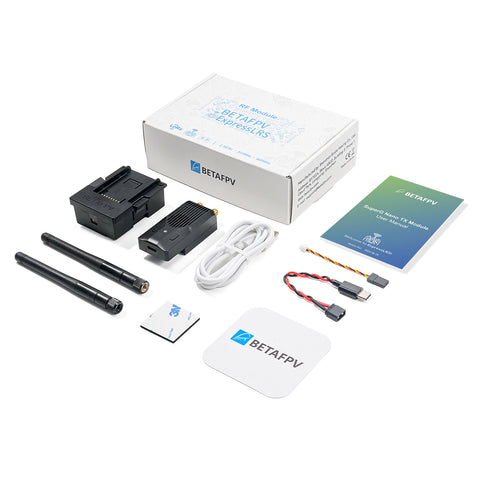












 Drone service
Drone service Rental
Rental Reliability
Reliability Trust
Trust Own warehouse
Own warehouse  Warranty
Warranty